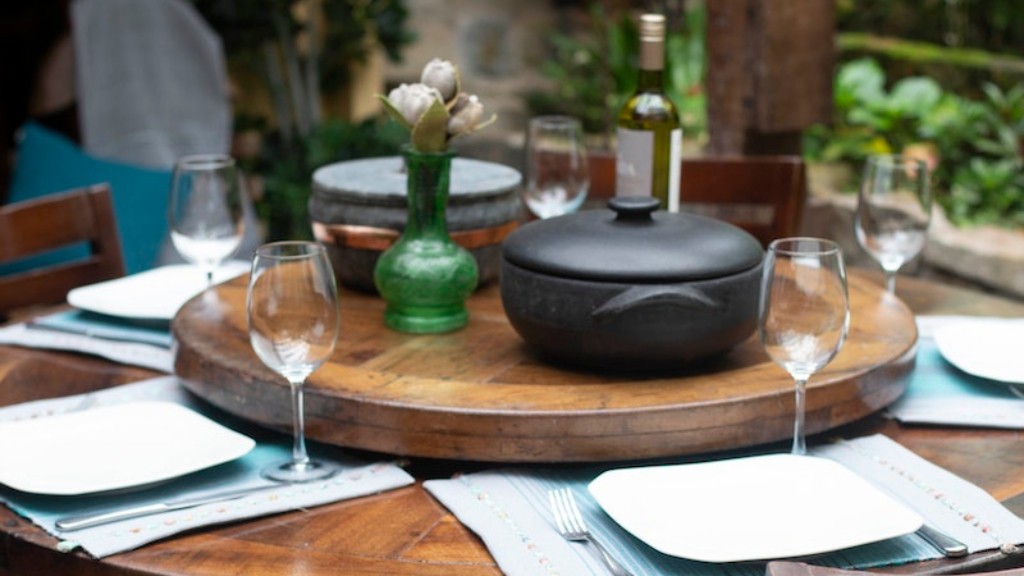In recent years, the restaurant industry has seen a shift towards virtual restaurants. A virtual restaurant is a restaurant that exists only online, with no physical location. Customers order through a delivery app or website, and food is prepared in a shared kitchen space.
There are many benefits to opening a virtual restaurant. For one, it is a cost-effective way to enter the restaurant industry. There is no need to lease a space, purchase expensive equipment, or hire a large staff. Additionally, virtual restaurants are not bound by geographic location, so they have the potential to reach a wider customer base.
If you are interested in starting a virtual restaurant, there are a few things you will need to do. First, you will need to secure a commercial kitchen space. This can be done by renting a kitchen space, partnering with another restaurant, or working with a commissary kitchen. Next, you will need to create a menu and brand for your restaurant. Once you have these things in place, you will need to promote your restaurant through delivery apps and social media.
Opening a virtual restaurant can be a great way to get started in the food industry. With a little planning and effort, you can be up and running in no time!
To open a virtual restaurant, you’ll need to create a menu, find a food delivery partner, and build a loyal customer base. Creating a menu is key to success—it should be simple, with a focus on a few key items that can be delivered quickly and easily. Once you have your menu, reach out to local food delivery partners to see if they’re interested in working with you. You’ll also need to market your new restaurant to potential customers, so they know you exist and what you’re all about. Finally, focus on creating a loyal customer base by delivering great food and service.
How do I create a virtual restaurant brand?
1. Create a concept: What kind of restaurant do you want to create? What will your menu be like? What is your target audience?
2. Decide on your target audience: Who do you want to reach with your virtual restaurant?
3. Set your kitchen up for success: Make sure your kitchen is set up for success by having the right equipment and ingredients on hand.
4. Build your brand: Your virtual restaurant’s branding should be reflective of your concept and target audience.
5. Perfect your packaging: Your food packaging should be well-designed and functional.
6. Connect to tech: Utilize technology to reach your target audience and make ordering easy.
7. Launch your virtual restaurant: Follow these steps and you’ll be on your way to launching a successful virtual restaurant!
A virtual restaurant is a great option for those who want to have a full menu but do not have the space or resources to have their own physical restaurant. These menus only exist online on platforms like Grubhub and are only for delivery. Virtual restaurants use a shared kitchen with another business to cook their food. This can be a great way to get started in the restaurant business without a lot of upfront costs.
How to make a virtual kitchen
There are a few things to keep in mind when starting your own virtual kitchen. First, you will need to learn the local laws and regulations regarding food preparation and storage. Next, you will need to build your menu. Be sure to include items that are easy to transport and that will stay fresh for your customers. Once you have your menu set, you will need to find a location for your kitchen. This can be a rented space or even your home kitchen, as long as it meets the necessary requirements. After you have your location set up, you will need to identify sourcing for produce and to-go packaging. This can be done through local farmers markets or online retailers. Finally, you will need to find a partner or partners to help you with the business. This could be someone who can help with the cooking or someone who has experience in the online ordering space. By following these steps, you can be on your way to starting your own successful virtual kitchen.
A virtual kitchen is a great way to earn additional revenue with little to no cost. By partnering with a well-known brand, you can use your current kitchen and staff to host a delivery-only virtual kitchen. This will allow you to offer these items to customers using a separate, virtual-only menu on DoorDash.
Is online restaurant profitable?
There are a few reasons for this. First, customers have the ability to order whatever they want without feeling rushed or pressured by a waiter. Secondly, customers can see all of the available options and make informed decisions about what they want to order. And finally, customers can take their time to peruse the menu and make sure they are getting exactly what they want.
In short, online ordering gives customers the freedom to spend more money on their meal because they are in control of the ordering process. As a result, adding online ordering to your restaurant’s services is a great way to boost profits and drive revenue.
If you’re looking to open a virtual restaurant brand that will rake in delivery orders, there are a few key steps you’ll need to take.
1. Find the right concept. What menu will hit it big on the apps?
2. Test your idea in the market. Tweak dishes, reframe photos, and change names and prices until it works.
3. Optimise costs.
4. Focus on quality.
5. Do your marketing right.
Do ghost kitchens make money?
Ghost kitchens are a popular new concept in the restaurant industry, and they can be quite profitable if managed correctly. Depending on the cost of food and local KPIs, ghost kitchens can usually become profitable within the first two years of operation. By sales forecasts and average revenue, you can estimate how long it will take for your ghost kitchen to become profitable. If all goes well, you can expect to see a healthy return on your investment within a few short years.
Are you looking to create a restaurant app? Here are some steps you can follow:
1. Conduct Market Research and Track Down the Issue
2. Work on a Business Plan
3. Select a Reliable Software Development Partner
4. Decide on UI/UX Design
5. Data Safety and Protection
6. Development Process and Testing
7. Application Launch with Pre- and Post-Marketing
What’s the difference between a ghost kitchen and a virtual restaurant
A ghost kitchen is a restaurant that exists exclusively online and is listed on food delivery apps, with no traditional “restaurant” space. All of the food is prepared in ghost kitchens.
Ghost kitchens are established restaurants and commercial kitchens with no dine-in space for guests. They typically use third-party delivery services to bring the food to customers’ homes or offices.
So why open a ghost kitchen? For many restaurants, the traditional dine-in model is simply not profitable anymore. The high costs of rent, labor, and food make it difficult to turn a profit. But by eliminating the need for a dine-in space, ghost kitchens can be much more profitable.
Another benefit of ghost kitchens is that they can be located anywhere. They don’t need to be in a high-traffic, high-rent area. This means that they can be located closer to where the food is actually prepared, which can save on transportation costs.
If you’re thinking of opening a ghost kitchen, there are a few things to keep in mind. First, you’ll need to choose a good location. Second, you’ll need to invest in good quality kitchen equipment. And third, you’ll need to make sure you have
There are many things to consider when starting a food business from home. The first step is to choose the right set of cuisines. Define your business model – Cloud kitchens, Dhabas, or something else. Check for the licenses and permissions you need. Manage sourcing ingredients, inventory, and packaging. Choose delivery partners. These are just a few of the things to consider when starting a food business from home.
What is a virtual restaurant brand?
Virtual brands are growing in popularity as a way to starting a food or beverage business with minimal overhead costs. A ghost kitchen is a commercial kitchen that is not open to the public – it is used solely for the preparation of food that is delivered to customers. These businesses often utilize third-party delivery services to get their product to customers.
There are a few advantages to starting a virtual brand. First, it is a relatively low-cost way to get started in the food and beverage industry. Second, ghost kitchens often have access to better equipment and resources than a home kitchen, which can help produce a higher quality product. Finally, by utilizing a delivery service, virtual brands can reach a wider customer base than a brick-and-mortar business.
The main downside of virtual brands is that they can be harder to build a connection with customers. Without a physical space for customers to come and interact with the brand, it can be difficult to create a loyal following. Additionally, customers may be less likely to try a new virtual brand if they have never heard of it before, which can make it harder to get new businesses off the ground.
Are you a passionate home cook looking for an avenue to share your culinary creations? If so, starting a virtual cooking club may be the perfect way to do so! Here’s how to get started:
1. Decide on the type of virtual cooking club you want. Will it be focused on trying new recipes, cooking with seasonal ingredients, or mastering specific techniques?
2. Choose how frequently your virtual cooking club will meet. Will it be once a week, biweekly, or monthly?
3. Select your virtual platform. Will you use Zoom, Skype, Google Hangouts, or another platform?
4. Choose your club members. Start by inviting friends, family, or fellow foodies who you think would be interested.
5. Settle on menu ideas. Will everyone make the same dish or will everyone cook something different and share?
6. Time to cook! Get everyone together virtually and cook up a storm. Be sure to take pictures or videos of your creations.
7. Have fun! This is your chance to show off your skills, share your love of cooking, and connect with others who share your passion.
8. Eat your hard
Who pays for DoorDash food
If you’re ever in doubt, just ask your Dasher app – it will always let you know whether you need to pay for an order with your Red Card or not. In general, though, you’ll need to pay for food orders with your Red Card, but you can grab and go for many others.
DoorDash is a food delivery service that operates in many cities across the United States. As long as DoorDash is available in a city, you can sign up to be a driver and start earning money. DoorDash is a great way to make money while traveling, as you can work in many different cities and make money as you go.
How do I start a small food business from home?
If you’re thinking about starting a food business, there are a few key things you need to do to get started. First, you need to develop a solid business plan. This will help you secure the financing you need to get your business off the ground. Next, you need to choose a location for your business. Once you’ve chosen a location, you need to design the layout of your space. After that, you need to choose your suppliers. Then, you need to get your licences and permits in order. Once you have all of that squared away, you can start hiring your employees. Finally, you need to advertise your business to get customers in the door.
A virtual restaurant is a restaurant that exists only online and does not have a physical location. Customers order food from a virtual restaurant through a delivery service or online platform, and the food is then prepared by a professional chef and delivered to the customer’s door.
Virtual restaurants have become popular during the COVID-19 pandemic due to the increase in social distancing and work-from-home policies. With more people staying at home, there is a greater demand for convenience and delivery services. Virtual restaurants provide a convenient solution for people who want to enjoy restaurant-quality food without having to leave their homes.
There are a number of advantages to opening a virtual restaurant. First, it is a low-cost way to start a restaurant business. There is no need to rent or build a physical space, and all of the necessary equipment can be rented or purchased second-hand. Second, virtual restaurants have less overhead costs than traditional restaurants, which means that they can pass on savings to customers in the form of lower prices. Third, virtual restaurants are not limited by geography, so they can reach a wider audience than brick-and-mortar restaurants.
If you’re thinking of starting a virtual restaurant, there are a few things you need to
Do restaurant owners make a lot of money
Quite a few factors affect how much restaurant owners can expect to earn in salary each year. Location, size, menu offerings, and amenities all play a role in annual salary projections. On average, restaurant owners can see salary ranges from $33,000 to $155,000 a year.
There are a few different types of restaurants that tend to be more profitable than others. Bars have some of the highest profit margins, due to the fact that they can charge higher prices for drinks. Diners also tend to be quite profitable, due to the low cost of breakfast food ingredients. Food trucks can be quite profitable as well, due to the fact that they often have lower overhead costs than brick-and-mortar restaurants. Delivery pizzerias and pasta restaurants also tend to be quite profitable, as they can charge higher prices for their dishes.
Warp Up
There is no one-size-fits-all answer to this question, as the best way to open a virtual restaurant depends on the specific business and its goals. However, some tips on how to open a virtual restaurant include studying the market and identifying a niche, developing a business model and creating a menu, and creating an online presence. Additionally, it is important to promote the virtual restaurant to potential customers and ensure that the ordering and delivery process is smooth.
There are many ways to open a virtual restaurant. You can start by creating a website or blog and posting recipes. You can also create a Facebook page or Twitter account and share recipes and cooking tips. You can also create a YouTube channel and share cooking videos. If you want to open a virtual restaurant, you need to be creative and have a passion for cooking.





